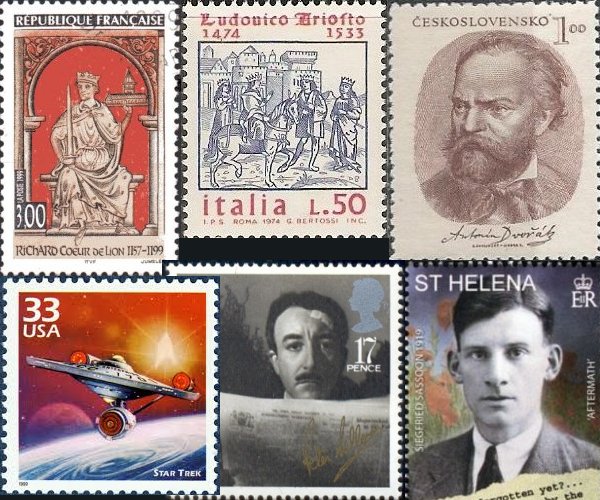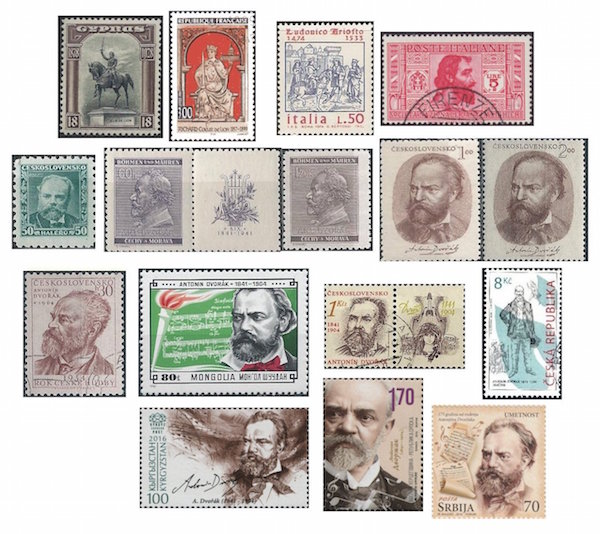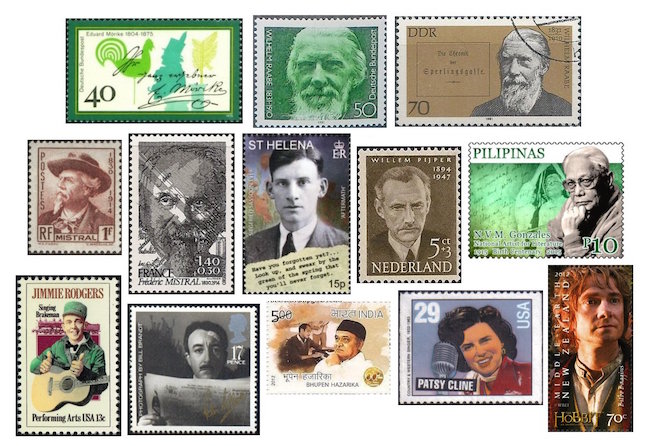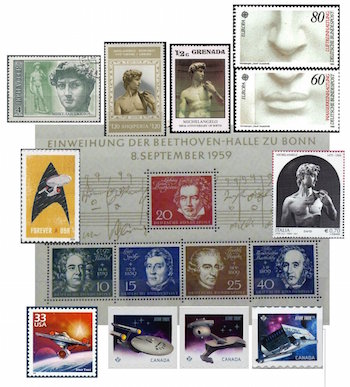The Arts on Stamps of the World — September 8
An Arts Fuse regular feature: the arts on stamps of the world.

By Doug Briscoe
Quite a big day, as many distinguished figures in the arts have a September 8 birthday, Ariosto, Dvořák, Mörike, Siegfried Sassoon, and Peter Sellers among them.
We begin, though, with the 12th century, and with royalty. English King Richard the “Lionheart” (8 September 1157 – 6 April 1199), besides being a warrior, was also a poet and a singer. Wikipedia says that only “two poems by Richard are extant, of which only ‘Ja nus hons pris’ survives with music.” This song was composed while Richard was famously held captive at Dürnstein Castle in Austria in 1192-3. The Cypriot stamp was issued in 1928, while Cyprus was part of the British Empire, and the French stamp marks the 800th anniversary of the king’s death.
One of the great poets of the Renaissance was Ludovico Ariosto (1474 – 6 July 1533), who coined the term “humanism” (umanesimo) to reflect the new intellectual focus on human achievement as opposed to the long-standing Christian emphasis on humanity’s subordination to God. Ariosto’s great work was the huge epic poem Orlando Furioso, which served as the source for many musical works, particularly for the stage. But even before the invention of opera his words were set as early as 1555 by such composers as Lassus, who wrote about fifteen pieces to Ariosto’s texts over the course of some thirty years. One of the earliest known operas is La liberazione di Ruggiero dall’isola d’Alcina (1625) by Caccini. Vivaldi dealt with the subject of Orlando Furioso twice, in 1714 and again in 1727. Handel’s Orlando (1733), Ariodante, and Alcina (both 1735) all have stories derived from the great epic. In France, Lully (Roland of 1685) and Rameau (Les Paladins from 1760) were among the composers inspired. In the Classical period, Haydn (Orlando paladino, 1782) and others continued the tradition. As late as 1843, Ambroise Thomas wrote a one-act comedy called Angélique et Médor based on Ariosto. Interest seems to have dwindled considerably in the 20th century, but Charles Ives wrote a song on the words “La fede mai” in 1920.
Today is the birthday of one of my favorite composers and, I’m convinced, one of the greatest, yet one who is largely overlooked by the general public: Antonín Dvořák (8 September 1841 – 1 May 1904). Everybody would recognize his Humoresque, and most people have heard of the “New World” Symphony, but that leaves a treasure trove of magnificent scores. Dvořák wrote in all genres: opera, sacred music, solo piano pieces, choruses and songs; but it is in the symphonic and chamber arenas, in my view, that he shone brightest. In my radio days I used to introduce the Sixth as “the greatest 19th-century symphony that is not generally recognized as a great 19th-century symphony.” He wrote what I regard as the world’s greatest cello concerto (pace Elgar fans). Obviously, I could go on and on about this, but let’s talk about the stamps. I present them in chronological order, with the one at upper left having been issued in 1934. Next to that is a pair that came out for the composer’s centennial, which took place in 1941, when Czechoslovakia was under the Third Reich. At that time, the Germans issued stamps for the Czech region as “Bohemia and Moravia” (Böhmen und Mähren), and perhaps surprisingly condescended to acknowledge Dvořák while some other Böhmen und Mähren stamps depicted people like Wagner and Hitler himself. Next we have a post-war pair from 1951 and (next row) a standalone issue from 1954. Then we see a Mongolian (!) stamp from a 1981 group honoring various Western composers. A Czechoslovakian sesquicentennial issue of 1991 comes next, and finally, there’s a stamp from the Czech Republic dated 2004. Last year three new Dvoøák issues came out for the 175th anniversary of his birth: one each from Kyrgystan (!), Bosnia-Herzegovina (under Serbian administration), and Serbia.

German poet and fiction writer Eduard Mörike (1804 – 4 June 1875) has a famous musical association with his novella Mozart auf der Reise nach Prag (Mozart on the Journey to Prague, 1856), but in addition his poems were set by many great and not-so-great composers: Schumann, Brahms, Hugo Wolf, Max Bruch, Rheinberger, Pfitzner, Reger, Distler, Schoeck (whose stamp was presented here just a week ago), and Alban Berg. Mörike, a pastor and teacher of German literature at Stuttgart, also translated Theocritus and Anacreon and was much admired by Wittgenstein.
Also active at Stuttgart in these years was Mörike’s countryman and fellow novelist Wilhelm Raabe (September 8, 1831 – November 15, 1910). He worked in a bookstore for some years and amply fed his hunger for reading. While studying philosophy at Berlin he tried his hand at a novel that met with some success, and he was off and running. By the end of his life he had written some thirty novels and numerous stories. His earlier works, which he published under the pseudonym Jakob Corvinus, were largely pleasant tales of ordinary people. There was a contrasting angst-ridden period reflecting the pessimism of Schopenhauer, and then a final, humor-laced period that showed the influence of Dickens and Thackeray. Raabe also left hundreds of drawings and some paintings like Farmers’ Cottages in a Heath Landscape.
Frédéric Mistral (8 September 1830 – 25 March 1914) won the Nobel Prize (shared with José Echegaray) in 1904 for his poetry. He was a Provençal and strove to resurrect and maintain the Occitan language and culture, founding an organization, the Félibrige, for the promotion of the language, and devoting many years to the creation of a museum, the “Museon Arlaten“, for the display of Provençal folk art and crafts. Mistral also put together an Occitan-French dictionary that is still in use. His poetry, needless to say, was composed in that language, culminating in the long poem Mirèio (Mireille, 1859). His work was championed by Alphonse de Lamartine and Alphonse Daudet.
Another much-admired poet of a later age was the Englishman Siegfried Sassoon (8 September 1886 – 1 September 1967), best remembered for his war poems. Unlike his contemporaries Wilfred Owen and Rupert Brooke, he survived World War I and went on to produce a fuller body of work. Sassoon was born to a Baghdadi Jewish father and an Anglo-Catholic mother, a member of the Thornycroft family of prominent sculptors. There was no German heritage—the name Siegfried came of his mother’s love of Wagner. He joined up when war broke out but soon was brought short by the horrors of the trenches, of which he wrote unsparingly in his poems. He met kindred spirit Robert Graves at this time. Sassoon was cited again and again for his reckless bravery, which Graves described as suicidal. After the war he became friendly with William Walton, who dedicated his Portsmouth Point Overture to the poet. Another friend was E.M. Forster. After a visit to the United States Sassoon turned to prose, producing a three-volume fictionalized autobiography, the Sherston Trilogy, along with further volumes of memoirs. Though married with a child, Sassoon enjoyed a series of relationships with male partners, including Ivor Novello.

The first symphony (1917) of highly gifted Dutch composer Willem Pijper (1894 – 18 March 1947) was a conscious tribute to Mahler and sounds very much like the Austrian master. Pijper’s later music, including two more symphonies, was more “modern”. What little I’ve heard, three concertos and four of his short string quartets, along with a couple of other things, has always impressed me very favorably. The stamp was issued by the Netherlands in 1954, seven years after the composer’s death. Willem Pijper (pronounced, I believe, more or less like “paper”) was also important as a music critic.
Filipino novelist N(éstor) V(icente) M(adali) González (September 8, 1915 – November 28, 1999) played violin in his youth and crafted four guitars with his own hand. He became a journalist and began publishing essays and poems in the mid-1930s. At Stanford he took courses with Wallace Stegner and Katherine Anne Porter, later himself becoming a teacher at a number of universities both in the Philippines and the United States (UC Berkeley and others). The stamp was just issued in 2015.
Our next five (!) consecutive artists were all popular entertainers of one kind or another. Earliest born among them was early country singer James Charles “Jimmie” Rodgers (September 8, 1897 – May 26, 1933), known for his yodeling. Having been a railroad worker he came to be known as “The Singing Brakeman”, though other nicknames included “The Blue Yodeler” and “The Father of Country Music”. He made all his numerous recordings between 1927 and his early death from tuberculosis in 1933.
Next in chronological order (and the one who gets my vote for the greatest of the group) was the splendid Peter Sellers (born Richard Henry Sellers; 8 September 1925 – 24 July 1980). It’s funny—ahem—to note that fellow Goon Show regular Harry Secombe (8 September 1921 – 11 April 2001) shared a birthday with Sellers. Like Siegried Sassoon, Sellers had one Jewish parent (in his case, his mother, to whom he was very close.) He was a gifted sketch artist and played drums. After serving (in some capacity) in World War II, he entered television in 1948 and films in 1950. The Goon Show ran from 1951 to 1960. I remember hearing somewhere that, relative to his multiple performances in Dr. Strangelove, director Stanley Kubrick said that with Sellers, he got “three actors for the price of six.” (Sellers was originally going to play the role of Major Kong, too.)
Best known as a singer, musician, and lyricist, Bhupen Hazarika (8 September 1926 – 5 November 2011) also directed or composed music for many films (invariably different projects—that is, he never directed films for which he had written the music, or vice-versa). He was born in Assam and wrote mostly in the Assamese language.
Country singer Patsy Cline (born Virginia Patterson Hensley; September 8, 1932 – March 5, 1963) had perfect pitch but could not read music. She made her first recording and her first television appearance in 1955. One of her biggest hits was 1961’s “Crazy”, written by Willie Nelson. Nearly killed in a car accident just two months before recording that song, Cline died in a private air plane crash at the age of 30.

The superb English actor Martin Freeman (born 8 September 1971), who is on a New Zealand stamp because he played Bilbo Baggins in the Peter Jackson Hobbit trilogy, is well known also for his appearances opposite Benedict Cumberbatch as Sherlock Holmes’ factotum Dr. Watson. You may also remember him in the original English version of The Office and in the delightful, richly cast comedy Love, Actually (2003); but to me his most impressive and brilliant work thus far was as the weaselly character of Lester Nygaard in the first season of the Fargo TV series.
Besides birthdays today, we have a few other anniversaries to note. On this date in 1504, Michelangelo‘s David was unveiled in Florence. On the master’s birthday I showed a substantial batch of Michelangelo stamps, but these six were not among them.
The reconstructed Beethoven-Halle in Bonn held its first concert on this date in 1959. There had been a temporary structure built in 1845 at the time of the inauguration of the Beethoven Monument. A new hall went up in 1870 for the Beethoven centennial, but that building was destroyed by Allied bombing on October 18, 1944. President Theodor Heuss laid the cornerstone for the new structure in 1956, but the hall was not complete until 1959. The first concert, held 58 years ago today, opened appropriately enough with Beethoven’s Consecration of the House Overture. The opening was commemorated with the issuance of a souvenir stamp sheet that also took the opportunity to honor various death anniversaries of Handel, Haydn, and Spohr and Mendelssohn’s 250th birthday.
The very first episode of Star Trek to be broadcast, “The Man Trap”, aired on Thursday, September 8, 1966 at 8:30pm on NBC. The first USS Enterprise stamp came out in the big millennium set that looked back on highlights from the decades of the twentieth century, this one, obviously, a milestone from the 1960s. The more recent one came out last year for the fiftieth anniversary of the TV series. Canada also issued Star Trek stamps on the same occasion (Bill Shatner and James Doohan were both Canadian born), and from that set I show another Enterprise along with a Klingon warship. The set was such a success that Canada issued a followup group this year, from which I offer the image of a Federation shuttlecraft.
Two performers not yet recognized on stamps, but I think deserving of them, are French actor and mime Jean-Louis Barrault (8 September 1910 – 22 January 1994), most famous for his role in the magnificent film Children of Paradise (Les Enfants du Paradis, 1945), and the great and brilliant Sid Caesar (September 8, 1922 – February 12, 2014).
A graduate of the University of Massachusetts with a B.A. in English, Doug Briscoe worked in Boston classical music radio, at WCRB, WGBH, and WBUR, for about 25 years, beginning in 1977. He has the curious distinction of having succeeded Robert J. Lurtsema twice, first as host of WGBH’s weekday morning classical music program in 1993, then as host of the weekend program when Robert J.’s health failed in 2000. Doug also wrote liner notes for several of the late Gunther Schuller’s GM Recordings releases as well as program notes for the Boston Classical Orchestra. For the past few years he’s been posting a Facebook “blog” of classical music on stamps of the world, which has now been expanded to encompass all the arts for The Arts Fuse.
